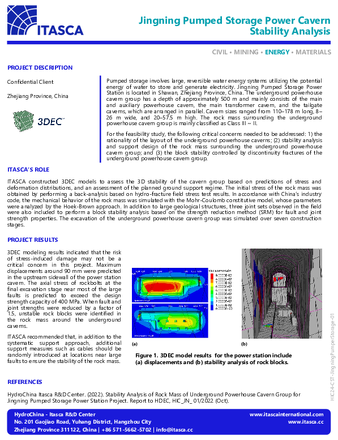Jingning Pumped Storage Power Cavern Stability Analysis
Project Description
Pumped storage involves large, reversible water energy systems utilizing the potential energy of water to store and generate electricity. Jingning Pumped Storage Power Station is located in Shawan, Zhejiang Province, China. The underground powerhouse cavern group has a depth of approximately 500 m and mainly consists of the main and auxiliary powerhouse cavern, the main transformer cavern, and the tailgate caverns, which are arranged in parallel. Cavern sizes ranged from 110–178 m long, 8–26 m wide, and 20–57.5 m high. The rock mass surrounding the underground powerhouse cavern group is mainly classified as Class III ~ II.
For the feasibility study, the following critical concerns needed to be addressed: 1) the rationality of the layout of the underground powerhouse caverns; (2) stability analysis and support design of the rock mass surrounding the underground powerhouse cavern group; and (3) the block stability controlled by discontinuity fractures of the underground powerhouse cavern group.
ITASCA's Role
ITASCA constructed 3DEC models to assess the 3D stability of the cavern group based on predictions of stress and deformation distributions, and an assessment of the planned ground support regime. The initial stress of the rock mass was obtained by performing a back-analysis based on hydro-fracture field stress test results. In accordance with China’s industry code, the mechanical behavior of the rock mass was simulated with the Mohr-Coulomb constitutive model, whose parameters were analyzed by the Hoek-Brown approach. In addition to large geological structures, three joint sets observed in the field were also included to perform a block stability analysis based on the strength reduction method (SRM) for fault and joint strength properties. The excavation of the underground powerhouse cavern group was simulated over seven construction stages.
Project Results
3DEC modeling results indicated that the risk of stress-induced damage may not be a critical concern in this project. Maximum displacements around 90 mm were predicted in the upstream sidewall of the power station cavern. The axial stress of rockbolts at the final excavation stage near most of the large faults is predicted to exceed the design strength capacity of 400 MPa. When fault and joint strengths were reduced by a factor of 1.5, unstable rock blocks were identified in the rock mass around the underground caverns.
ITASCA recommended that, in addition to the systematic support approach, additional support measures such as cables should be randomly introduced at locations near large faults to ensure the stability of the rock mass.

References
HydroChina Itasca R&D Center (2022). Stability Analysis of Rock Mass of Underground Powerhouse Cavern Group for Jingning Pumped Storage Power Station Project. Report to HDEC, HIC_JN_ 01/2022 (Oct).

